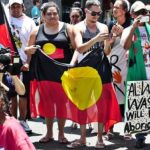Lack of Post-Release Support Leads to Indigenous Deaths and Re-offending

When it comes to the prison population in Australia, the Indigenous are heavily over-represented. As of 30 June 2015, Aboriginal and Torres Strait Islander people comprised 9,885 out of 35,845 people incarcerated in Australian correctional facilities.
Australia’s First Peoples make up 3 percent of the nation’s population. However, they represent 27.5 percent of the population behind bars. They are fourteen times more likely to be in custody than the country’s non-Indigenous people.
In NSW over the fifteen years ending in 2015, the number of Indigenous people held on remand awaiting trial increased by 238 percent. 40 percent of those people were not ultimately sentenced to imprisonment.
The level of Indigenous incarceration in the Northern Territory beggars belief – with Aboriginal and Torres Strait Islanders making up around 85 percent of that jurisdiction’s prison population.
Indigenous deaths in custody
The Australian Indigenous prisoner population has almost doubled from the 14 percent it was in 1991, which was the year the Royal Commission into Aboriginal deaths in custody delivered its findings. At that time, there was one Indigenous death in custody every eleven days.
After four years of investigating 99 Aboriginal deaths in custody that occurred between the years of 1980 and 1989, the royal commission made 339 recommendations. Next to none of them have ever been implemented.
The commissioners identified the principal reason for ongoing deaths in custody as the disproportionate rate First Nations peoples were being detained, arrested and imprisoned.
Preventable tragedies
Indigenous deaths in custody continue. There was the tragedy of Ms Dhu, who died in a lockup at WA’s South Hedland police station in 2014. Her only offence was unpaid fines. Ms Dhu made repeated pleas for help, as she was injured and in pain. However, police claimed she was faking it and treated her accordingly.
Ms Dhu later died of a heart attack linked to septicaemia and pneumonia resulting from her broken ribs.
Thirty-six-year-old Rebecca Maher from the NSW central coast died in a holding cell at Maitland police station last July. Her’s was the first Aboriginal death in custody in NSW since 2000. Ms Maher’s only crime was to be intoxicated on the side of the road.
A last resort
The commission’s eighty seventh recommendation states, “arrest people only when no other way exists for dealing with a problem,” while the ninety second says, “imprisonment should be utilised only as a sanction of last resort.”
These recommendations have fallen on deaf ears, and the Aboriginal prison population continues to skyrocket. By 2013, there had been 365 Indigenous deaths in prison and police custody since the end of the royal commission.
An epidemic of post-release deaths
However, Melbourne University researchers have found that Aboriginal and Torres Strait Islander people are even more likely to die in the days and weeks after they’re released from prison, than in custody.
These deaths are likely to be caused by alcohol-related harms, preventable diseases and suicide.
Unfortunately, little research has been undertaken into this issue and preventative measures are virtually non-existent.
The majority of incarcerated Indigenous inmates are also repeat offenders. The high rates of reoffending and post-release deaths suggest that these people are not receiving adequate assistance under current programs and policies.
Murri activist weighs in
Since the 1980s, the chair of the Indigenous Social Justice Association, Ken Canning, has been aware of the acute post-release trauma suffered by Indigenous people. In fact, Mr Canning recommended that the royal commission investigate the situation.
Mr Canning made this recommendation because the deaths are “heavily related to incarceration,” he told Sydney Criminal Lawyers®. “People die as a result of the horrific conditions they’re subjected to in custody.”
He added that he’s seen many people engaging in conduct they never would have even considered before serving time. And often, this behaviour leads to their deaths.
“It needs further investigation,” Mr Canning explained. “It needs medical and academic investigation into the subject of why people are dying not long after coming out of custody.”
Peer group reintegration
Mr Canning has as intimate understanding of these issues, and now works as an Aboriginal support worker at the Rainbow Lodge in Glebe.
The lodge acts as a gateway for young Indigenous men who are reintegrating back into the community. It provides newly released inmates with a place to stay for their first three months after release.
As Canning is older than a lot of the men he works with, he acts like a bit of a mentor, and the younger men respect his experience and maturity.
In the same way that these young men look up to him, Canning sees the need to implement programs where respected community elders are into prisons to advise and assist inmates.
Returning to the community
A 2014 evaluation of three post-prison release programs delivered by Indigenous community-controlled health organisations found that intensive and coordinated care immediately after release provides benefits when it comes to reintegrating back into the community.
However, there is not enough funding to sufficiently carry out the services. And with a lack of understanding and research into the situation, there’s little impetus for further investment.
According to Mr Canning, what is needed are programs that begin six months prior to offenders being released. And as the Murri activist points out, programs with a focus on the needs of Indigenous people can incorporate culturally specific solutions into the methodology.
A revolving door
As Mr Canning explains it, many Indigenous people who are released from prison see themselves as trapped in a destructive cycle. “I see people who are so institutionalised or marginalised that they expect to go into gaol,” he observes.
“I know a few who say, ‘Let’s just get out. Have a good time. Before they put me back in,’” Mr Canning will tell you that this attitude develops well before anyone steps into a correctional facility. It stems in part from the systemic racism found in the way authorities police the streets.
Prejudice from the beginning
Mr Canning gives the example of the inner-city suburb of Glebe. “You’ve got a suburb where under 1 percent of the population is Aboriginal, but the stop and search rate is over 11 percent,” he said. “Now there’s a problem right there.”
“Over-representation of people being stopped and searched,” Canning adds, leads to over-representation of people being charged with minor offences, and in turn involvement with the criminal justice system.
This over-policing of Aboriginal and Torres Strait Islanders is one of the main reasons for their over-representation in the prison system. As Canning see it, this is the problem “we’ve had since 1788.”








